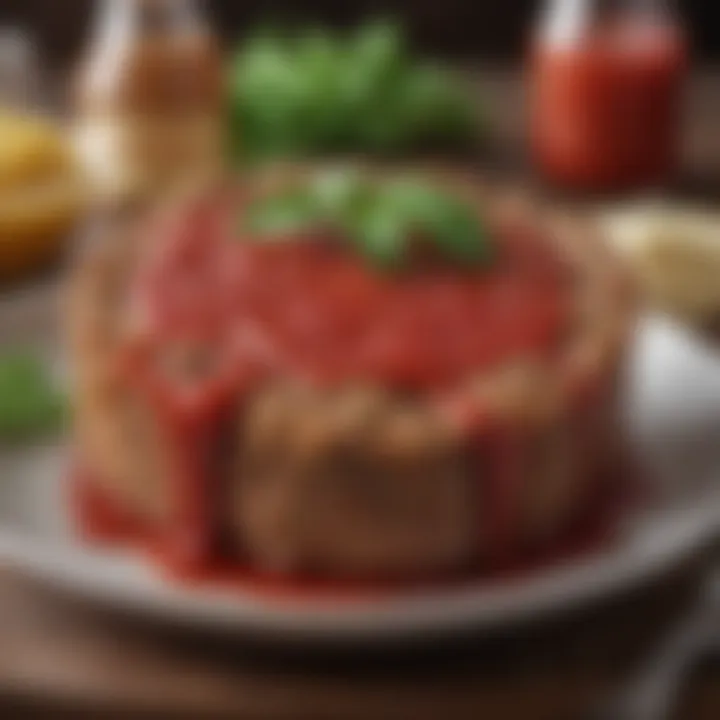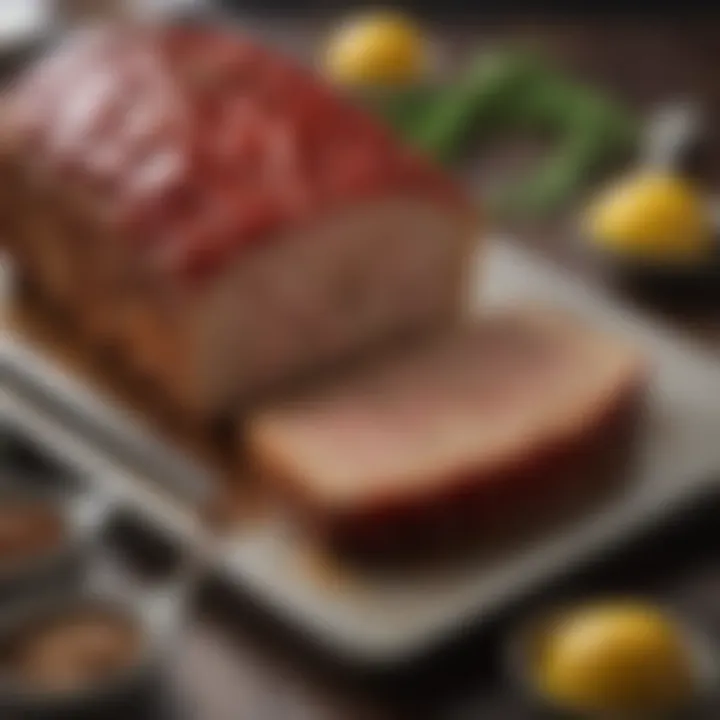Mastering Beef Meatloaf: A Comprehensive Guide


Intro
Creating a beef meatloaf is more than just a culinary task; it’s an art that merges tradition with personal flair. This dish has graced dinner tables for generations, embodying a comforting blend of flavors and textures. It’s a recipe that tells stories of home, families gathered around the table, and the warmth that good food brings. But what exactly makes a meatloaf truly special? In this exploration, we will dissect each layer of this meaty marvel, from ingredient selection to technique mastery.
Meatloaf is often perceived as a simple meal. Yet, digging deeper reveals the complex balance of seasonings, the perfect combination of meats and fillers, and techniques that elevate the dish from mundane to magnificent. Whether you are a kitchen novice or an experienced chef, understanding the nuances of meatloaf can significantly enrich your cooking repertoire.
Let's embark on this journey to craft a delightful beef meatloaf that not only satisfies the palate but also elevates your cooking game.
Recipe Overview
Recipe Name
Classic Beef Meatloaf
Brief Description of the Dish
This Classic Beef Meatloaf is a savory delight, combining ground beef with a symphony of ingredients to create a hearty meal. With a luscious glaze and a tender texture, it’s a dish that is both reassuring and satisfying. Each slice holds a rich flavor profile that resonates with the essence of home-cooked goodness.
Ingredients List
Main Ingredients
- Ground Beef: The star of the show; prefer lean ground beef for balance.
- Breadcrumbs: Help bind the meatloaf and provide texture.
- Eggs: Acts as a binder, keeping everything cohesive.
- Onion and Garlic: For depth of flavor.
- Milk: Keeps the meatloaf moist and flavorful.
- Salt and Pepper: The basic yet essential seasonings.
Optional Ingredients
- Ketchup or BBQ Sauce: For a glazed finish or added sweetness.
- Bell Peppers or Carrots: Adding vegetables can enhance flavor and nutrition.
- Herbs: Parsley or thyme can provide fresh notes.
- Cheese: A sprinkle of parmesan or cheddar can add richness.
One of the beautiful aspects of meatloaf is its adaptability. It’s a blank canvas that welcomes creativity and personal touch in every bite, ensuring each version is uniquely yours.
Preamble to Beef Meatloaf
When it comes to classic comfort food, few dishes can rival the heartiness and homely charm of beef meatloaf. This dish is not merely a meal; it offers a sense of nostalgia and warmth, often embodying the heart of family gatherings. Beef meatloaf is versatile, able to adapt to personal tastes and creative inclinations. A thorough exploration into meatloaf reveals its historical roots and significance across cultures, providing a deeper appreciation for this beloved dish.
Historical Context
Beef meatloaf has origins that stretch back centuries and reflect the practicalities of earlier cooking styles. Many trace its ancestry to the European meat dishes of the medieval period, where the need to stretch ingredients led to the blending of meat with fillers like breadcrumbs or rice. This was a clever way to make a small amount of meat go further, catering to both economic constraints and culinary creativity. In the United States, meatloaf became a staple during World War II, when rationing made beef scarce, and women at home needed to create bountiful meals for their families.
The dish has evolved significantly over time, with regional adaptations and personal twists becoming common. In rural areas, you might find meatloaf laced with local flavors, while city dwellers may throw in exotic spices for a modern touch. Notably, cookbooks from the mid-20th century played a pivotal role in popularizing meatloaf. These books highlighted its practicality as a make-ahead meal that could be reheated throughout the week. The affection for meatloaf became almost synonymous with nostalgia for many, creating a comfort food icon in the United States.
Cultural Significance
Meatloaf isn’t just a dish; it carries layers of meaning across various communities. In American households, it signifies family dinners and Sunday potlucks, where friends and family gather to share laughter and stories around the dinner table. The dish transcends mere sustenance; it represents togetherness, warmth, and tradition. It's often considered a rite of passage for novice cooks—an entry point into understanding the nuances of seasoning and texture.
Moreover, meatloaf expresses cultural identity through its many variations. For instance, the Italian meatloaf, or "polpettone," often incorporates herbs like basil and parsley, showcasing regional flavors while retaining the foundational concept of a meat-based dish. Meanwhile, in Mexico, you may find a meatloaf enriched with spices such as cumin and chili powder, reflecting the local palate.
This adaptability makes beef meatloaf a blank canvas for culinary expression, inviting home cooks to experiment with ingredients and techniques, whilst still paying homage to its rich history. As comfort food, its importance remains strong, reminding individuals of family heritage and love for food that feeds both the body and soul.
"The essence of comfort food lies in its ability to remind us of home, family, and the simple pleasures of life."
As we dive deeper into the specifics of crafting the perfect beef meatloaf, we will explore the essential ingredients, preparation techniques, cooking methods, and more. Each aspect will guide you toward mastering this historical yet evolving dish.
Essential Ingredients for Beef Meatloaf
To create a beef meatloaf that stands tall among culinary offerings, one must start with the right ingredients. Each component plays a pivotal role in determining not just the flavor, but the texture and overall satisfaction of the dish. Understanding the essential ingredients sets the stage for a meatloaf that is both savory and memorable.
Choosing the Right Beef
Types of Beef Cuts
When it comes to selecting the right beef for your meatloaf, the cut can make all the difference. Ground chuck is often the cut of choice; it strikes a delectable balance between fat and lean meat. The primary characteristic of ground chuck is its robust flavor, which lends a hearty backdrop to your meatloaf. Another popular option is ground sirloin, known for being leaner, although it can sometimes lack the juiciness that chuck provides. Choosing ground round can also work, but this cut can skew drier if not properly managed.
The unique feature here is the fat content inherent in the cuts. More fat generally means more moisture and flavor, leading to a gate-keeping decision for the taste of your final product. While leaner cuts may be tempting for health reasons, they are likely to dry out, leaving a meatloaf that could end up more like a brick than a delicious dinner staple.
Fat Content Considerations
The fat content is an essential aspect that cannot be ignored when crafting the perfect beef meatloaf. Typically, a fat content of around 15-20% is optimal, as this balance prevents the loaf from being greasy while still keeping it moist. The beauty lies in the marbling; the flecks of fat within the meat provide flavor and contribute to a pleasing mouthfeel. Too much fat, however, can result in an overly oily texture, so careful selection is key.
The ideal fatty beef not only makes cooking more forgiving but also enhances flavor complexity, giving each bite that extra wow factor. Though it may be tempting to lean towards leaner choices, such as ground turkey, the luxurious texture and flavors you attain through the appropriate beef cuts are hard to replicate.
Binding Agents
Breadcrumbs vs. Oats
Binding agents keep the structure of the meatloaf intact, binding the flavorful fillings and ingredients. Breadcrumbs are a classic choice, absorbing moisture while helping maintain form. They're known for lending a softer texture that many find appealing. Oats, on the other hand, are gaining popularity, bringing a heartier texture and a touch of nuttiness to the dish.
Both options have their merits. Breadcrumbs offer ease of use and familiarity; however, oats can increase fiber content while still pulling flavors together nicely. If opted correctly, this switch can elevate a basic meatloaf into something richer and more satisfying.
Role of Eggs


Eggs play a crucial role in meatloaf, functioning as a binding and leavening agent. The protein in eggs helps to hold everything together, ensuring the loaf retains its shape while cooking. A critical characteristic of eggs is their ability to add moisture, which counteracts the potential dryness of the meatloaf.
Using eggs also promotes a uniform texture throughout the dish, enhancing the overall mouthfeel. One disadvantage, though, is that too many eggs can cause the meatloaf to become overly dense, absorbing moisture rather than contributing to it. Finding the right balance is important to keep the meatloaf convenient and palatable.
Flavor Enhancers
Herbs and Spices
Flavor enhancers are the life and soul of beef meatloaf. Herbs and spices breathe warmth and complexity into the dish, transforming it from generic to exceptional. Classic choices include salt, black pepper, thyme, and parsley. The persona these ingredients lend your meatloaf cannot be overstated; they create dynamic flavor profiles that make forks clatter and conversation flow.
Adding a pinch of cayenne or smoked paprika can unexpectedly elevate the flavor, providing that extra kick. The unique aspect of using herbs and spices is their adaptability; they can be tailored to suit any palate, making each family recipe truly one-of-a-kind.
Onions and Garlic
Onions and garlic are widely regarded as essential flavor enhancers, bringing a depth that makes the meatloaf sing. Their inherent sweetness during the cooking process balances beautifully against the rich beef. Diced onions can add a slight crunch once cooked, while garlic infuses the dish with warming aromas that captivate the senses.
One unique feature here is that sweet onions, like Vidalia, may yield a pleasantly softer taste compared to yellow onions. They can actually change the entire mood of the meal. However, be careful with garlic; too much can overpower the dish. Finding the right amount ensures harmony and balance.
Toppings and Glazes
Classic Ketchup
Ketchup remains the undisputed classic topping for meatloaf. The tangy sweetness of ketchup not only adds moisture but can also enhance the overall eating experience. Its sticky texture allows it to glaze the surface beautifully while baking, creating an appealing crust.
The simplicity of ketchup makes it an easily accessible choice for home cooks, while its acidity cuts through the richness of the beef, providing a balanced meal. However, some might find the sweetness a tad overwhelming if slathered excessively.
Alternative Glazes
While ketchup reigns supreme, alternative glazes can offer exciting surfaces and flavors. A mixture of BBQ sauce or even a honey glaze can add a lovely twist, adding a layer of caramelization as it cooks. The unique characteristic here is their versatility; swapping glazes can completely redirect the focus of the dish and reflect personal preferences or seasonal inspirations.
However, remember to balance flavors and textures. Some glazes may hinder the crust formation, potentially leading to a soggier meatloaf. In this regard, experimentation can become a double-edged sword. Finding what suits your taste best requires testing, and that's half the fun in cooking!
Preparation Techniques
When it comes to crafting an outstanding beef meatloaf, the preparation techniques are crucial. These methods set the stage for ensuring your meatloaf not only tastes amazing but also has the right texture and moisture balance. Getting these techniques right allows flavors to meld beautifully and gives your meatloaf a delectable finish worthy of any table.
Mixing Ingredients
Mixing the ingredients correctly is foundational to a successful meatloaf. It's about achieving that perfect blend of flavors and textures without compromising the structural integrity of the dish.
Avoiding Overmixing
A common pitfall when making meatloaf is overmixing the ingredients. When you knead or mix too vigorously, it can lead to a dense, tough texture. Avoiding overmixing ensures that the meatloaf remains tender and juicy; think of mixing as giving your ingredients a gentle hug rather than a wrestling match. This characteristic is essential, as it maintains the meat’s natural juiciness and keeps everything cohesive without creating a rubbery texture. One unique feature is that it allows air to remain within the mixture, which can enhance the overall mouthfeel. Ultimately, avoiding overmixing results in a more enjoyable eating experience.
Texture Considerations
Texture is often the unsung hero of any meatloaf. The right texture means a pleasant bite and a wholesome experience with each forkful. Focusing on texture involves considering the size of your chopped ingredients, like onions or garlic. Uniform pieces can create a harmonious mix that feels satisfying in each bite. A classic technique involves lightly sautéing these ingredients to release their flavors while keeping them tender. Adapting the ingredients during this step can yield a delightful variety of texture, with contrasting elements that play nicely off each other. While too heavy a hand can compromise this balance, proper texture contributes enormously to the overall appeal of the dish.
Shaping the Meatloaf
Once you’ve mixed your ingredients to perfection, the next step is making sure they take the right shape for cooking. The shaping process affects not only cooking time but also the final presentation of the meatloaf.
Loaf Form vs. Pan Method
In the world of meatloaf shaping, there's a significant choice between the loaf form and pan method. The loaf form is often seen as traditional, wherein the mixture is shaped by hand into a loaf on a baking sheet. This method encourages even cooking and develops a crispy crust, providing a delightful textural contrast. On the other hand, using a loaf pan can create a more uniform shape, which is easy to slice and serve. Each approach has merits, with the loaf form being more visually appealing while the pan method lends itself to convenience. Depending on your preference, selecting the right method can contribute effectively to the eating experience.
Size and Shape Impacts
The size and shape of your meatloaf can greatly influence how it cooks and how it's served. A thicker meatloaf might take longer to cook, while a thinner one would cook faster yet run the risk of drying out.
It's advisable to aim for a shape that’s conducive to even cooking—think of it like building a small ‘hill’ rather than a giant ‘mountain.’ A uniform thickness ensures that every slice enjoys the same flavor profile and moisture level. Additionally, making smaller, individual loafs can also add a unique twist to your presentation and cooking methods. The choice you make here can have lasting impacts on both texture and taste as you sit down for dinner.
Cooking Methods
The method of cooking beef meatloaf is pivotal to achieving the desired taste and texture. Each technique brings its own flavor profile and tenderness to the table, making it essential for any home chef or seasoned culinary artist to understand the pros and cons of each approach. Whether one is baking, slow cooking, or grilling, the techniques you choose can significantly modify the overall experience of your meatloaf dish. Here, we will dissect the three primary cooking methods used for beef meatloaf, detailing their nuances and the impact they have on this classic dish.
Baking in the Oven
Optimal Temperature
When it comes to baking beef meatloaf, the optimal temperature typically hovers around 350°F (175°C). This temperature allows for even cooking while ensuring the meatloaf retains moisture and flavor.
A key characteristic of this temperature is its balance; it’s hot enough to cook the meat thoroughly but not so high that it risks drying it out. At 350°F, the exterior develops a nice crust, while the inside remains juicy. However, an oven at too low of a setting might lead to undercooked meat, while a higher temperature can lead to overcooking the edges before the center is ready. This makes 350°F a prevalent choice among chefs and home cooks alike.
Cooking Times
Cooking times are another crucial element to consider. Generally, a meatloaf weighing around 2 pounds should bake for about 1 hour to 1 hour and 15 minutes. This helps it reach the ideal internal temperature of 160°F (70°C).
The unique feature here is the need to monitor the progress closely. While recipes typically provide a standard cooking time, actual timings can vary based on the oven's efficiency and the specific size and shape of the meatloaf. This variability means that it’s wise to use a meat thermometer for precision. Not only does achieving the right cooking time ensure food safety, but it also enhances flavor and texture, making it critical in the overall crafting of a perfect meatloaf.
Slow Cooking Techniques


Benefits of Slow Cooking
Slow cooking beef meatloaf can transform it into a tender and flavorful dish. The process breaks down tough fibers in the meat, allowing for a melt-in-your-mouth experience that is hard to replicate through other methods.
One standout feature is how the low, steady heat allows flavors to meld over time, resulting in a depth of taste that many find irresistible. Including vegetables such as onions or carrots into the slow cooker can add even more layers to the flavor profile. While some may say that the time investment is high, many also find that the ease of simply setting it and forgetting it makes slow cooking a coveted method.
Adjusting Cooking Times
Cooking times in a slow cooker can vary significantly, generally falling between 6 to 8 hours on low, or 3 to 4 hours on high. The adjustment of these times directly impacts how tender the meatloaf becomes.
Experienced cooks often suggest checking the meatloaf about an hour before you expect it to be done. This approach not only imparts better moisture retention but also allows for a cautious assessment of doneness. Using a meat thermometer here too is crucial. A benefit of this method is the ability to extend cooking times without a significant risk of overcooking. Yet, patience is mandatory, as it doesn't offer the immediate gratification of other cooking methods.
Grilling as an Alternative
Flavor Profile Differences
Grilling meatloaf introduces a charred, smoky flavor that many find delightful. Cooking over an open flame or hot coals brings out nuances that aren’t easily achieved through baking or slow cooking.
The standout aspect of grilling lies in the high heat applied, creating a caramelized crust that seals in juices, leaving the inside beautifully moist. This method can also be a bit trickier, as it requires close attention to avoid flare-ups that can lead to uneven cooking. Grilling is a more adventurous route for meatloaf, often favored for summer barbecues, but it demands certain skills to get right.
Achieving Proper Cook
Achieving the proper cook when grilling is all about technique. Typically, the meatloaf should be cooked at a medium heat, aiming for an internal temperature of 160°F.
A unique feature of grilling is that it typically cooks faster than other methods, often within 40 to 45 minutes depending on thickness. The challenge is palatable, as undercooked meatloaf can present food-safety issues, while overcooked meat can turn it dry. The best approach is utilizing a grill thermometer, allowing you to monitor the cooking process accurately and produce a perfectly grilled meatloaf.
"Each cooking method for beef meatloaf contributes uniquely to its flavor, texture, and cooking experience. Understanding the nuances is key to mastering this culinary classic."
In summary, the choice of cooking method is fundamental when it comes to crafting the perfect beef meatloaf. Each technique—from baking to slow cooking to grilling—has its individual traits that can either make or break the final dish.
Serving Suggestions
Serving suggestions play a pivotal role in transforming a simple beef meatloaf into a memorable meal. This section delves into the ideal accompaniments and how to effectively store and reheat leftover meatloaf. When it comes to meatloaf, the right partners on the plate can elevate flavors, enhance presentation, and even make the meal more nutritious.
Accompaniments and Sides
Classic Mashed Potatoes
Classic mashed potatoes are a quintessential side dish that complements beef meatloaf beautifully. Their creamy texture and buttery flavor pair perfectly with the savory meatloaf, creating a comforting dish that evokes a sense of nostalgia. One key characteristic of mashed potatoes is their smoothness; when prepared correctly, they provide a contrasting mouthfeel to the hearty loaf. This side is not just popular because it's tasty, but also due to its flexibility – you can add garlic, cheese, or herbs to personalize it.
One unique feature of classic mashed potatoes is their ability to absorb the delicious drippings from the meatloaf, enhancing each bite and reducing food waste. However, it is essential to consider that if mashed potatoes are prepared too far in advance, they can become gluey, losing that desirable fluffiness. Thus, timing is everything.
Seasonal Vegetables
Seasonal vegetables are another wonderful addition to a meatloaf dinner. They provide a fresh, vibrant contrast to the richness of the beef. Each season brings a different crop, from green beans in the summer to hearty root vegetables in the winter, making this option not only healthy but dynamic throughout the year. Their key characteristic is the variety; you can roast, steam, or sauté various vegetables depending on your preference and time constraints.
A distinctive feature of seasonal vegetables is their nutritional value; loading your plate with colorful veggies ensures that your meal is not only flavorful but also packed with vitamins. While they may require a bit more prep time than mashed potatoes, the health benefits and enhanced flavor they bring to your meatloaf experience are worth the effort.
Storage and Reheating Options
Knowing how to properly store and reheat leftover meatloaf is crucial, especially if you've made a larger batch. Following best practices ensures that flavors are preserved and food safety is maintained.
Proper Storage Techniques
When it comes to proper storage techniques, the first rule of thumb is to let the meatloaf cool down to room temperature before placing it in the refrigerator. This minimizes condensation, which can impact texture. Wrapping the meatloaf in plastic wrap or placing it in an airtight container not only retains additional moisture but also protects it from absorbing other odors in your fridge. A notable benefit of proper storage is that well-preserved meatloaf can last for up to four days, making it an excellent option for meal prep.
However, it’s worth noting that if you intend to keep leftovers longer, freezing is a viable option. Just be sure to slice it into portions for easier defrosting. The downside? Freezing might alter the texture slightly, so it's best to consume within a few months.
Reheating Methods
Reheating methods can dramatically influence the final taste and texture of your beef meatloaf. One popular method is using an oven; wrap the meatloaf in aluminum foil and heat it at 325°F until warmed through. This technique preserves moisture and helps avoid that dreaded dry texture. Alternatively, if you're short on time, the microwave is an option; however, be cautious to not overdo it, as this can result in a rubbery consistency.
A unique advantage of reheating in an oven is that it can rejuvenate flavors, giving the meatloaf a fresh feel, making it seem as good as the day it was made. The drawback is it takes longer compared to the microwave, which may not suit everyone’s schedule.
"The right accompaniments and proper storage can enhance not just your meal today but set you up for success tomorrow."
In summary, the way you serve and later store your beef meatloaf can greatly impact the overall dining experience. Keeping these tips in mind will help ensure your culinary creation is enjoyed to its fullest potential.
Variations on Traditional Beef Meatloaf
Exploring variations of traditional beef meatloaf opens a door to a world of flavors and interpretations. This topic is essential because it highlights the adaptability of meatloaf, a dish often seen as a culinary cornerstone. By understanding how different cultures make this dish their own, cooks can enhance their culinary repertoire and engage in a delightful journey through diverse taste profiles.
Regional Adaptations
Italian Meatloaf
When diving into Italian Meatloaf, it’s almost as if a classic dish gets dressed up in a tuxedo. The critical aspect of this variant is the use of Italian seasonings and ingredients. Incorporating elements such as Parmesan cheese, fresh herbs like basil and oregano, and perhaps a splash of marinara sauce elevates this meatloaf to new heights.
This key characteristic makes Italian Meatloaf a beloved choice in kitchens seeking warmth and tradition in their meals. Its robust flavor serves as a flavorful twist on the standard beef meatloaf recipe, making it a popular pick for family gatherings or Sunday dinners.


A unique feature of this Italian style is its ability to blend flavors harmoniously. The moist mixture of beef and cheese often leads to a meatloaf that is richer and more satisfying. On the flip side, the inclusion of additional ingredients can make it more prone to becoming too dense if not balanced correctly.
Mexican Flavors
Turning to Mexican Flavors, one can infuse meatloaf with a variety of bold tastes that really kick up the experience. Think chipotle, cumin, and fresh cilantro—these spices can turn an ordinary meatloaf into a fiesta on a plate. This variation’s heart is its vibrant profile, which is bursting with flavors that boldly reflect its cultural roots.
The key characteristic of a meatloaf styled with Mexican flavors lies in its zest. This version is not just food; it's an experience. It can be beneficial for those looking for something adventurous and far removed from the usual fare. The unique feature here is the optional addition of ingredients like diced peppers or corn, introducing sweetness and crunch where one would expect a uniform texture.
However, it’s important to navigate these flavors carefully, as overly spicy or complex combinations can overwhelm rather than complement the dish. Finding right balance is essential, as it keeps the meatloaf approachable while still being exciting.
Health-Conscious Alternatives
In an era where health is paramount, health-conscious alternatives to classic meatloaf are emerging as a necessary consideration for many. These alternatives focus on lighter and healthier variations without sacrificing taste.
Using Leaner Cuts
When talking about Using Leaner Cuts, the implication is crystal clear: it's all about reducing the fat content while keeping the flavor intact. Choosing cuts like sirloin or ground turkey brings a lighter profile to the table. This change is especially important for those watching their dietary intakes but still wanting to enjoy a comforting meal.
A key characteristic of lean meats is that, while they can make for a healthier overall dish, they also require careful cooking. Overcooking lean beef can lead to dryness, which is a common pitfall in traditional meatloaf recipes. However, the advantage here is unmistakable; not only are health-conscious eaters satisfied, but they also feel good about their choices.
Vegetable Additions
On the other side, incorporating Vegetable Additions can lead to a nutrient-packed twist to traditional beef meatloaf. Adding finely chopped veggies like carrots, zucchini, or spinach into the mixture enhances the flavor while boosting the nutritional profile. It’s a wonderful way to sneak in extra nutrients, especially for those who might be a bit picky about eating their greens.
The main advantage is twofold: increasing the dish’s moisture and enhancing its nutritional value. However, one must be cautious. Too many vegetables can alter the texture, making the loaf crumbly or mushy if not considered properly.
In summary, variations of traditional beef meatloaf not only offer an exciting culinary twist but also provide a diversifying option for health-conscious eaters. By embracing different flavors and healthier ingredients, you create an inviting meal that respects the dish’s rich history while also looking to the future.
Common Mistakes and Fixes
Crafting a flawless beef meatloaf can be a bit of a balancing act. Even seasoned cooks can occasionally trip over the same mistakes, leading to a less-than-stellar dish. Understanding these common pitfalls and how to remedy them not only enhances your culinary repertoire but also contributes to mastering the art of meatloaf making. It’s like having a map that helps you navigate the culinary landscape, ensuring you're equipped to serve up a success each time.
Identifying Overcooked Meatloaf
Symptoms of Overcooking
The most glaring symptom of overcooked meatloaf is dryness. When you slice into the loaf and discover a crumbly texture, it’s often a clear signal that you’ve cooked it too long. Overcooked meatloaf can also exhibit a toughness that’s decidedly unappetizing. The key characteristic to look for here is the moisture level; ideally, your meatloaf should be juicy and hold its shape without being mushy.
Noticing these symptoms early on can save your dinner plans from disaster. Nobody relishes the thought of serving a plate of dry meatloaf, right? An undercooked meatloaf, while not desirable, can at least provide a salvageable meal. However, when meatloaf turns dry, it’s like trying to save a sandcastle at high tide—you're mostly out of luck. A highlight here is that many cooks notice the aroma; an overcooked meatloaf tends to emit a burnt or slightly charred scent, suggesting time to pull it from the oven. This awareness can be quite handy when perfecting your technique.
Preventive Measures
To avoid the vexation of dry meatloaf, there are strategies worth considering. Firstly, keeping an eye on cooking time is essential. Use an instant-read thermometer, aiming for an internal temperature around 160°F (71°C). Another key tactic revolves around the choice of ingredients; opting for a blend of beef with a bit of fat can help maintain moisture throughout the cooking process.
By incorporating these measures, you not only enhance the quality of your meatloaf but can also improve your confidence in the kitchen. The unique feature of monitoring temperature is that it takes the guesswork out of the equation. While recipes often give cooking times, they can vary significantly depending on the oven and pan used. Hence, using a thermometer ensures consistent results, making this a beneficial method for anyone serious about mastering beef meatloaf.
Addressing Dry Meatloaf Issues
Causes of Dryness
One of the primary culprits behind dry meatloaf is often too much lean meat without sufficient fat. Lean cuts may help you feel virtuous, but they often lack the richness and moisture that fat provides. Additionally, not incorporating enough binding agents like breadcrumbs or oats can lead to a loaf that simply falls apart and dries out.
A standout aspect is that each person's definition of dryness can vary; some might expect a more succulent texture, while others might be used to a drier loaf due to traditional family recipes. Yet, understanding what makes meatloaf moist is a critical step toward culinary satisfaction. The unique feature of identifying causes of dryness helps address team cooking experiences where multiple factors might be at play, ensuring your contributions lead to a cohesive dish.
Moisture Retention Strategies
Successfully retaining moisture in your beef meatloaf involves a blend of art and science. One effective approach is melding vegetables such as grated zucchini or carrots into the mix; this not only adds flavor but hydrates the mixture as it cooks. Furthermore, using a water bath can create steam that envelops the meatloaf, contributing to a more succulent end product.
What stands out here is the versatility of moisture-retaining strategies. They allow for personalized tweaks that can cater to dietary preferences or flavor profiles. While experimenting can sometimes yield mixed results, the advantage here is in the learning process. Trial and error can often lead to delightful new recipes and techniques that enrich your culinary arsenal, making every attempt worthwhile.
End
In wrapping up our exploration of crafting the perfect beef meatloaf, it’s important to recognize the numerous layers involved in creating this beloved dish. The final moments of the cooking process mark not just the conclusion of the meal's preparation but also a celebration of the art of cooking itself. Mastering beef meatloaf is more than a set of recipes; it’s about weaving together history, cultural significance, and personal taste.
Reflecting on the journey of preparation, we can consider key elements that contribute to culinary success: the balance of flavors, the proper technique, and the careful choice of ingredients. Each bite of meatloaf can evoke memories of family gatherings, childhood dinners, or even personal achievements in the kitchen. It is a dish that has the capacity to connect generations, calling out to the cook’s innate sense of nostalgia.
Plus, understanding common mistakes and knowing how to troubleshoot issues like dryness or overcooking can be the difference between a good meatloaf and a glorious one. For those diving into the kitchen, these insights are invaluable.
"The kitchen is where memories are made, and beef meatloaf is often at the center of it all."
By becoming aware of the elements discussed in this article, readers are empowered not just to prepare their own dishes but to think critically about why certain methods work better than others, enhancing their culinary skill set entirely.
Reflections on Crafting Beef Meatloaf
Taking a step back, we can appreciate that crafting beef meatloaf is truly an expression of oneself. It is a balance act—a blend of taste and technique that allows for personal flair. Think of how many different families have their own cherished meatloaf recipes, passed down through the years, often altered just a tiny bit to suit individual tastes.
What one person loves about meatloaf might be different from another's preference; some might favor a smoky glaze, while others may opt for a rich, herbaceous filling. Reflecting on these variations offers a glimpse into personal histories, showcasing how a simple dish can adapt and evolve.
Creating beef meatloaf is a celebration of creativity. Throw in a stir of this or a pinch of that, and suddenly, the dish transforms into something uniquely yours. Don’t shy away from experimenting. It’s through these culinary experiments that skills develop, and flavors deepen, leading to delightful surprises.
Encouragement for Culinary Exploration
Culinary exploration goes beyond just following a recipe. It's about diving into the joy of discovery. Whether you are a novice or a seasoned pro, the kitchen offers endless opportunities for growth. Don't be afraid to try new things—regional adaptations, health-conscious substitutes, or bold flavor combinations.
Here are a few ideas:
- Explore International Flavors: Why not infuse Italian spices into your meatloaf, or perhaps some cumin for a hint of Mexican flair?
- Experiment with Ingredients: Consider adding unexpected elements like grated carrots or even a hint of horseradish to enrich your meatloaf.
- Engage with the Community: Share your creations and modifications on platforms like Reddit or Facebook to inspire and learn from fellow cooking enthusiasts.







